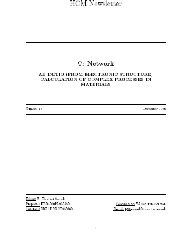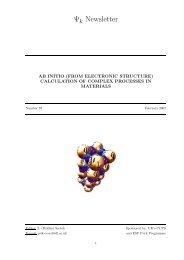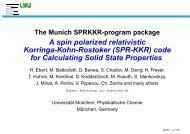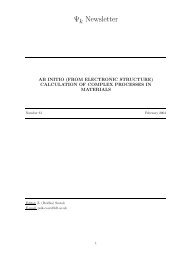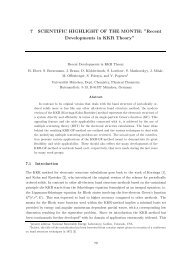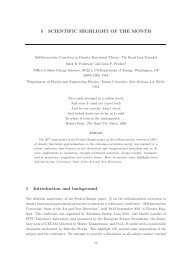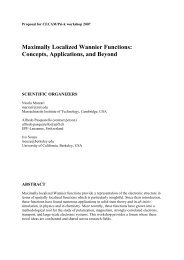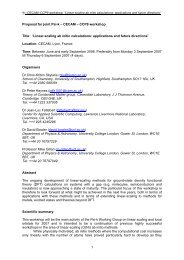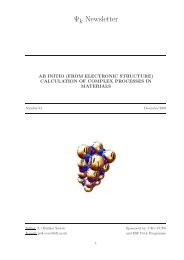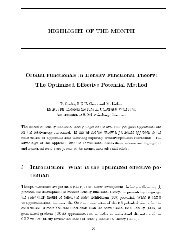Newsletter 107 - October 2011 - (pdf - 0.6 MB) - Psi-k
Newsletter 107 - October 2011 - (pdf - 0.6 MB) - Psi-k
Newsletter 107 - October 2011 - (pdf - 0.6 MB) - Psi-k
Create successful ePaper yourself
Turn your PDF publications into a flip-book with our unique Google optimized e-Paper software.
There are however a number of further aspects (approximations (i)-(iii) listed above) that<br />
could probably be improved. For example, as a result of approximating the logarithm as<br />
in Approximation (iii) above, the theory ends up having a pairwise additive form, with<br />
∑<br />
ij C ijR −6 behavior at large separations (compare Sect 4 above). This ∑ ij C ijR −6 longranged<br />
behavior means that the asymptotic vdW interaction for metallic systems will have<br />
the same exponent as for insulators in any geometry, contrary to known properties of thin<br />
metal or graphene sheets or metallic wires: see Sect 6.2 above. While the unusual behavior<br />
of such low-dimensional zero-gap systems at large distances is interesting, the force there is<br />
small and this alone would not constitute a serious disadvantage of the theory for practical<br />
binding calculations [59]. However the same pairwise property means that one might need<br />
to be careful about this functional for polarizable, highly anisotropic systems even in the<br />
non-asymptotic region of electron cloud overlap (see for example [37], [71], [41]). One<br />
should probably not be surprised that the theory appears not give a satisfactory account<br />
of the selective binding of graphene to specific metal surfaces [94], for example.<br />
8.3 New directions for ACFD-based vdW functionals<br />
It is tempting to try to go beyond the dRPA by using the ACFD (Eq (5)) but replacing<br />
the time dependent Hartree equation (6) of dRPA by the exact equation of linear Time<br />
Dependent Density Functional Theory (TDDFT) [101]:<br />
χ λ = χ 0 + χ 0 (λV + f xcλ )χ λ . (16)<br />
If the usual Adiabatic Local Density Approximation (ALDA) is used for the dynamic<br />
exchange-correlation kernel f xc , the ACFD energy from (16) is typically not improved<br />
over dRPA, because the ACFD energy samples all frequencies, not just low frequencies<br />
for which the ALDA is suited. Instead of this dRPA+ALDA approach, an ACFD energy<br />
formalism has been tried, with use of an ”energy optimized” local exchange correlation<br />
kernel f xc designed to improve the short ranged hole properties, and fitted to the xc energy<br />
of the homogeneous gas [102], [103]. This approach improved the energy over RPA for<br />
jellium spheres [104] and in fact it did better than the RPA+ approach described above<br />
in Sec 7.1. Other than this it has received little testing. The xc kernel f xc [n](⃗r,⃗r ′ ) used<br />
in these theories was local or semi-local in r and ⃗r ′ and had a similarly local functional<br />
dependence on the groundstate density n(⃗r ′′ ). However it has become clear that any<br />
beyond-dRPA theory of van der Waals interactions requires f xc to have a highly nonlocal<br />
functional dependence on n(⃗r ′′ ) A limited discussion of this is given in [14], and work is<br />
proceeding on a possible implementation of this idea.<br />
Even the simplest of the full many-body theories, the dRPA, is very costly numerically.<br />
For example a recent implementation [59] of dRPA for the binding energy curve E(D)<br />
of graphite as a function of the layer spacing D using an efficient periodic code was near<br />
the limit of present numerical capabilities despite the small size (4 atoms) of the unit<br />
cell of graphite. This was partly because of the need to sample k space finely near the<br />
59




